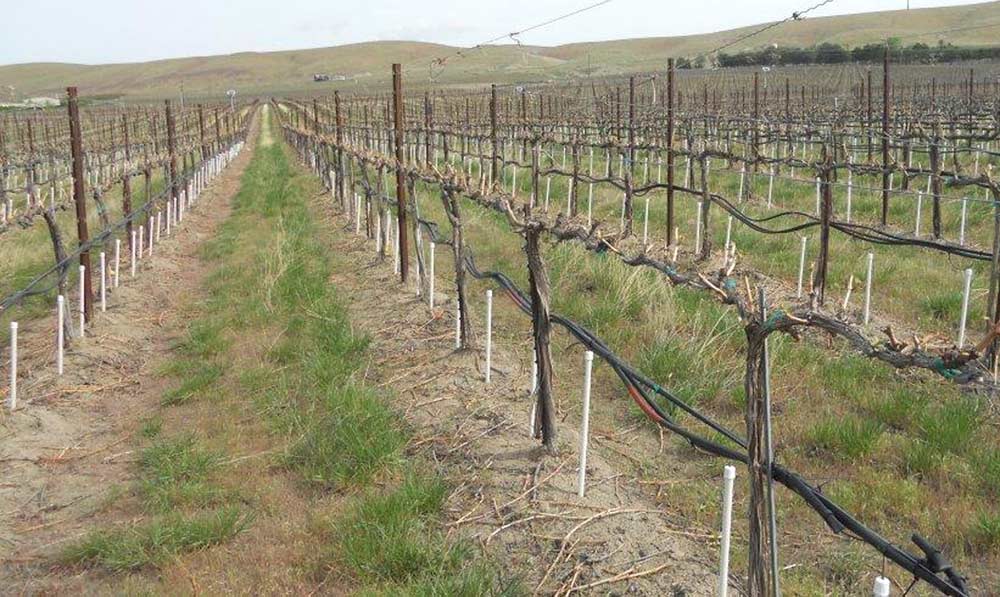
Irrigation is delivered directly to the root zone at varying depths with PVC pipes. Researchers hope that they can find the right level of water stress to keep vines and roots healthy but control canopy growth. (Courtesy Pete Jacoby)
An innovative irrigation system that showed promising yields and fruit quality despite drastic cuts in water use during the 2015 drought didn’t replicate its results in the second year.
That’s not bad news, according to lead researcher Pete Jacoby, who explained that the goal of the experiment was to test the limits of the vineyard.
“We applied season-long deficits that really stressed them. What we were trying to do by doing this was to see if we could sustain a vineyard during an extreme drought year — rather than abandoning it, could we sustain it with a limited amount of water?” said Jacoby, a soil scientist at Washington State University.
His experiment delivers irrigation — at 60, 30 and 15 percent of normal levels — to vines’ root zones through a subsurface delivery system made of PVC pipe. The idea is that by delivering the water directly to the root zone, it can drive deeper root growth and create a controlled level of stress that prevents excess canopy growth.
During the 2015 season, Jacoby’s deep deficit experiment in a Cabernet Sauvingon vineyard at 60 percent water use resulted in fruit yields just shy of those from a standard, commercially irrigated vineyard: 9 pounds per vine compared to 10. And at 15 percent of normal water, they still harvested 7.2 pounds per vine. But in 2016, those promising yields dropped dramatically.

These electronic controllers meter water directly to the root zone as part of an irrigation experiment designed to see how little water can sustain vines in a Cabernet Sauvignon block at Kiona Vineyards in Washington’s Red Mountain AVA. (Courtesy Pete Jacoby)
The control vineyard produced 14.8 pounds per vine; the 60 percent vines produced just over half that, with 8.4 pounds. And at the lowest end of the water use spectrum, 15 percent of normal water, the vines produced just 4.9 pounds of fruit per vine, of greatly reduced quality.
“We definitely had lower production in 2016 than we had in the first year of the experiment, and we know from the control that it was a better growing year,” Jacoby said. “Some of the literature suggest that if you have a lot of stress on the vine during a particular part of the growing season, that will carry forward — because those buds are set for the next year. We put tremendous stress on those plants in 2015, because it was the hottest and driest year on record, and combined with the water stress we applied, I have little doubt that we did have carry forward effect.”
This season, the experiment is shifting its approach slightly to use the deep delivery system with irrigation levels closer to commercial norms — 80, 60, and 40 percent — to find the “sweet spot” of water conservation and appropriate vine stress levels to improve canopy management and fruit quality.
They’ve also installed a deep delivery system in a Chardonnay block as well.
“Once we determine what the right amount is to sustain that vine and to get it to put its carbohydrate reserves into going deeper, we think we can limit the top growth very effectively without hurting the vine. This type of irrigation system could allow us to do a more precise job of deficit irrigation to protect vine health and improve fruit quality — without excess leaf growth and the money of canopy management,” Jacoby said.
While he’s not expecting many growers to retrofit their vineyards with his deep irrigation delivery system, Jacoby said a growing number of vineyard managers are interested in precision water management.
The tools he uses in his experiments to measure vine water use, such as infrared sensors to gauge water stress and detailed monitoring of loss to evaporation, are coming to commercial growers now. WSU is seeking grant funding to explore some of these tools and how to help growers apply them, Jacoby said.
“The long-term goal is to make our industry more competitive and at the same time to use the resources we have more efficiently,” he said. •
– by Kate Prengaman






Leave A Comment